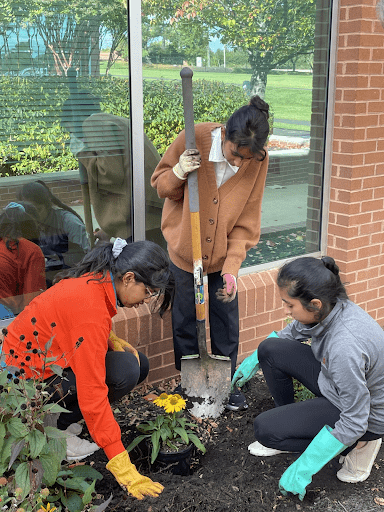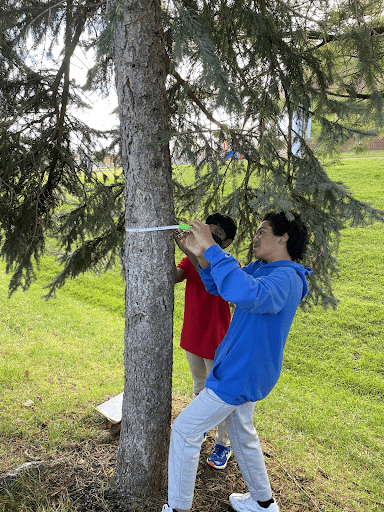Practical Tips for Teaching Effectively Outside

I recently participated in two workshops designed for teachers who want to add more outdoor learning to their curriculum. The first workshop, sponsored by NoVA Outside, was the Outdoor Learning Workshop on July 10, 2023. I had the privilege of organizing this event, which gathered K–12 teachers, administrators, and homeschool parents from northern Virginia. Together, we explored effective strategies, techniques, and valuable resources for incorporating outdoor teaching into our methods.
The second workshop focused on “Incorporating Nature Into the Curriculum” and was sponsored by the Fairfax County Public Schools Get2Green Program. This 5-day academy, held from July 17 to 21, 2023, was designed for FCPS teachers. During the workshop, I presented the environmental education materials available from Project Learning Tree and facilitated two PLT activities. I was so encouraged by the enthusiasm of the teachers and the great ideas shared that I felt compelled to share this information with the K–12 eePRO Group.

Teachers learn about milkweed's role in the monarch butterfly life cycle and how to integrate it across subjects like language arts, science, and art. Photo credit: Sheri Soyka

Project Learning Tree’s “Birds and Bugs” camouflage activity was a big hit with educators at NoVA Outside’s workshop. Photo credit: Joshua Holibonich

Educators at NoVA Outside’s workshop participated in a variety of environmental education activities for K–12th grade. Photo credit: Joshua Holibonich
The more we can engage students in outdoor learning the better because research has shown that time spent learning in a natural environment has tremendous benefits for students including:
- Improved academic achievement,
- Enhanced problem-solving and critical-thinking skills,
- Reduced symptoms of ADHD, and
- Lowered stress levels.
In addition, learning outside reinforces many skills that students need to be successful upon graduation such as collaboration, communication, and critical thinking. (Sources: Children and Nature Network - Research Digest; FCPS Get2Green - Why Take Students Outside; "Frontiers in Psychology - Do Experiences With Nature Promote Learning?")
Following are the tips, tricks, and resources teachers found most useful when scheduling, planning, and leading outdoor lessons:
Scheduling
- To avoid conflicts with other classes in the use of outdoor areas, such as courtyards and pavilions, consider using a school signup sheet to reserve the use of the space.
- Follow school protocols for letting the office staff know when and where you will be outside. This way, office staff can reach you or a student if necessary.
- If you will be a distance from the school building, take a first aid kit and phone and/or a walkie-talkie.
- Use field trip forms if you will be going off the school grounds.
- For large groups and/or longer outdoor learning sessions, consider asking for parent volunteers. Extra help can make outdoor learning more manageable, especially with large groups.
Preparation
- Check the outdoor areas ahead of time to note potential hazards, such as poison ivy, and find the best spot for your activity.
- Check the weather forecast and remind students in advance how to dress for outdoor activities. Have an alternate plan in case of bad weather.
- Gather needed supplies (clipboards, pencils, worksheets, tools, etc.). Depending on the number of supplies needed, consider using a box, tote, rolling cart, or wagon.
- Plan for how students will be involved. For example, determine if students will be working individually or in small groups. Consider assigning tasks to specific students for some outdoor experiences such as gardening (e.g., carrying supplies, digging the hole, placing the plant, watering the plant, taking photos, recording plant names and the location of the plants, and so forth).
Rules and Safety
- Before going outside, create ground rules with students for outdoor learning. Post the rules for students to easily see.
- Consider starting with shorter outdoor lessons to help establish proper student behavior.
- Set specific expectations for each outdoor lesson. You may want to give instructions inside and repeat them outside as necessary.
- Teach students the proper use of equipment and tools in a setting where they can easily see and hear you.
- Establish a meeting spot and bring a bell or chime to help gather students.
- Remind students not to eat wild plant leaves, berries, mushrooms, etc. If there are poisonous plants in the area, such as poison ivy, show them pictures and remind them not to touch these plants.

Educators at NoVA Outside’s workshop try Project Learning Tree’s’ “Web of Life” activity. Photo credit: Joshua Holibonich

Students working in the school pollinator garden. Photo credit: Sheri Soyka

Poison Ivy - “Leaves of 3, Let It Be.” Photo Credit: U.S. National Park Service
While Outside
- If you are not in an enclosed courtyard, set physical boundaries for the students to stay within. For example, tell students, “You have to be able to see me and I have to be able to see you!”
- Model the activities and outdoor skills needed for your lesson. Show them what you expect them to be doing.
- The outdoors is full of teachable moments. Use “I wonder” statements to engage students in critical thinking.
- Students should never be alone. If a student needs to go back to the building, send another student to accompany them.
Resources for K–12 Outdoor Lessons and Activities

Students collecting tree measurement data. Photo credit: Sheri Soyka
Visit "Teaching with i-Tree" to download a free activity guide that helps students calculate the dollar value of the many ecosystem services that trees provide. Available in English, Spanish, French, and Mandarin.
Let’s Share!
If you’re new to teaching outdoors, I hope these tips are helpful. If you’re a seasoned outdoor teacher, please share your tips, ideas, and resources in the comment section below.
Here’s to a wonderful year of teaching outdoors and inspiring students to be excellent stewards of our Earth!
About the Writer
Meet Sheri Soyka, a passionate 7th-grade environmental science teacher. With a background as Associate Director of Project Learning Tree and consulting roles spanning 15 years with Project WET, National Wildlife Federation, and Boys & Girls Clubs of America, Sheri brings a wealth of experience to her classroom, inspiring students through the power of environmental education. Sheri is also a co-moderator of the K–12 EE eePRO Group.
Join eePRO today and be a part of the conversation!
Comment and connect with fellow professionals in environmental education. Join eePRO >

